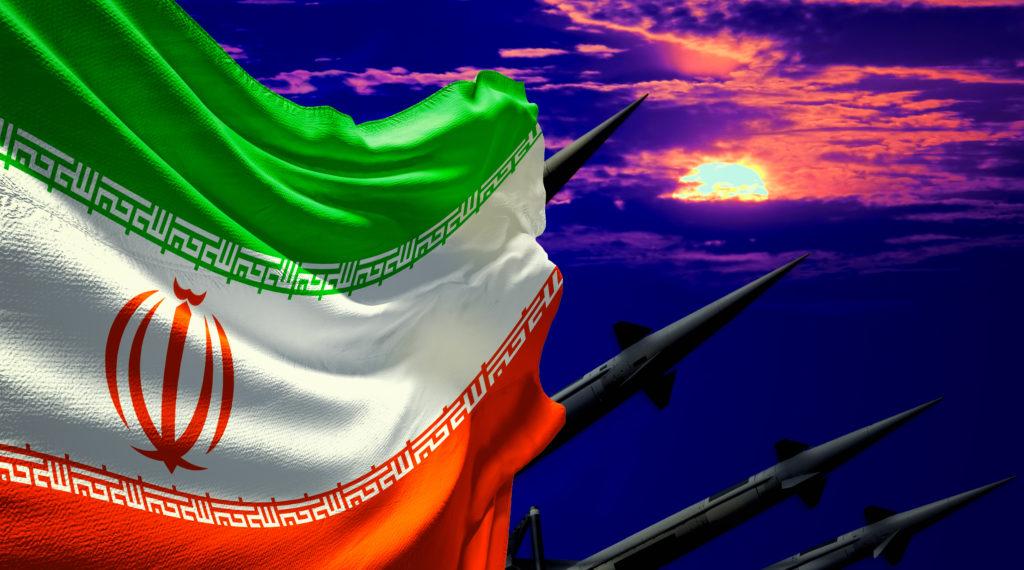Biden’s drive to war in the Middle East

Flag of Iran and Nuclear missiles on sunset sky background
Originally published by Israel Hayom
President Joe Biden’s Iran policy was conceived and is being implemented by the same people who negotiated the JCPOA under Obama, who argued in favor of empowering Iran.
On Monday, Iran tested a new rocket. The Zuljanah rocket is a 25-meter (82-foot) three-stage rocket with a solid fuel engine for its first two stages and a liquid fuel rocket for its third stage. It can carry a 225 kg (496-pound) payload.
The Zuljanah’s thrust is 75 kilotons, which is far more than required to launch satellite into orbit. The large thrust makes the Zuljanah more comparable to an intercontinental ballistic missile than a space launch vehicle. The US’s LGM-30G Minuteman-III land-based ICBM for instance, has 90 kiloton thrust. The Zuljanah can rise to a height of 500 kilometers for low-earth orbit or, if launched as a missile, its range is 5,000 kilometers (3,100 miles) – far enough to reach Britain from Iran.
Israeli missile experts estimate that Iran has paid $250 million to develop the Zuljanah project. Monday’s rocket launch itself likely cost tens of millions of dollars.
Iran is in deep economic distress today. Between the COVID-19 global recession, Iran’s endemic corruption and mismanagement and US economic sanctions, 35% of Iranians live in abject poverty today. Iran’s rial has lost 80% of its value over the past four years. Official data place the unemployment rate at 25% but the number is thought to be much higher. Inflation last year stood at 44% overall. Food prices have risen 59%.
When viewed in the context of Iran’s impoverishment, the government’s investment in a thinly disguised ICBM program is all the more revealing. With 35% of the population living in utter destitution and food prices rising steeply, the regime has chosen ICBMs over feeding its people.
Most of the media coverage of the Zuljanah launch failed to register the significance of the project both for what it says about Iran’s capabilities and what it says about the regime’s intentions. Instead, the coverage focused on the timing of the test. The Iranians conducted the test as they flamboyantly breach the limitations on their nuclear activities which they accepted when they agreed to the 2015 nuclear deal.
The Iranians are now enriching uranium to 20% purity – well beyond the 3.67% permitted under the so-called Joint Comprehensive Plan of Action, (JCPOA). They are using prohibited advanced centrifuges for enrichment in cascades at their Natanz nuclear installation. They are beginning uranium cascades with sixth generation centrifuges at their underground Fordo nuclear reactor in total defiance of the JCPOA. They are stockpiling uranium yellowcake far beyond the quantities permitted in the deal. They are producing uranium metal in breach of the deal. And they are test firing rockets that can easily be converted to nuclear capable ICBMs.
Reportage of Iran’s aggressive nuclear has presented it in the context of the new Biden administration in Washington. It is argued that Iran is taking these aggressive steps to pressure the Biden administration to keep its word to return the US to the JCPOA and abrogate economic sanctions on Iran. In 2018, then-President Donald Trump renounced the JCPOA and re-imposed the economic sanctions that were abrogated in 2015 with the deal’s implementation. Iran’s idea is that out of fear of its rapid nuclear strides, the Biden team will move urgently to appease Iran.
Notably, the Zuljanah test exposed the strategic insanity at the heart of deal, which was conceived, advanced and concluded by then-President Barack Obama and his senior advisors.
Click HERE to read more.
- The Biden administration’s war against the government of Israel - April 4, 2024
- The triumph of the blood libel - March 26, 2024
- Israel’s strategic game of survival - March 19, 2024
